Research
In the last years, graphene nanoribbons have attracted the attention of many research groups because of their fascinating properties.
In our group we are developing novel and alternative techniques to prepare these nanomaterials in a controlled way.
Unzipping of carbon nanotubes and nanofibers
 Different methods studied at the Terrones group to unzip carbon nanotubes and nanofibers
Different methods studied at the Terrones group to unzip carbon nanotubes and nanofibers
The Terrones group pioneered in developing alternative methods to unzip CNTs
(M. Terrones, Nature 458 (2009), 845-846 & M. Terrones ACS Nano 4 (2010) 1775-1781):
a) The Li-NH3 intercalation followed by exfoliation
(A.G. Cano-Marquez, M. Terrones, et al. Nano Letters 9 (2009) 1527-1533)
b) the catalytic metal longitudinal cutting of CNTs
(A.L. Elias, et al. Nano Letters 10 (2010) 366-372).
Therefore, we expect to have different families of GNRs and GCLs depending on the starting tube material:
SWNTs, DWNTs, MWNTs, CNx-MWNTs, COx-MWNTs, CBx-MWNTs and VGCFs.
The methods that we are developing are:
a) photophysical methods using laser sources and camera flashes in controlled atmospheres
(e.g. air, N2, He, Ar, etc.);
b) catalytic cutting in which metal nanoparticles (e.g. Ni, Co, Fe).
The Terrones group developed this method and will be optimized (A.L. Elias, et al. Nano Letters 10 (2010) 366-372);
c) soft chemical routes have been developed by Tour’s group
(D.V. Kosynkin, et al. Nature 458 (2009) 872-876) and the Terrones group (M. Terrones, Nature 458 (2009), 845-846; A.G. Cano-Marquez, M. Terrones, et al. Nano Letters 9 (2009) 1527-1533).
However, much softer chemical reactions are under investiogations;
d) novel mechanical methods involving mechanical ball milling of the nanotubes in different aqueous media
(e.g. alcohols, surfactants, polyelectrolytes and monomers),
followed by treatments in different solvents and ultra-centrifugation;
e) sonochemical methods, and
f) novel thermophysical methods,
in which abrupt Joule heating in controlled atmospheres (e.g. air, N2, He, Ar, etc.) is applied to nanotube arrays and nanotube films in order to unzip them efficiently
(X. Jia, M. Terrones, M.S. Dresselhaus, et al Science 323 (2009) 1701-1705).
Hybrid carbon/graphene structures
 Scheme showing the assembly of nanotubes and graphene to produce hybrid films
Scheme showing the assembly of nanotubes and graphene to produce hybrid films
With the availability of graphene sheets, we are combining them with nanotubes (1D), and creating fascinating multifunctional 3D architectures.
We will achieve this by connecting graphene with nanotubes via different synthetic and chemical routes, and explore the atomic scale nature of these interfaces formed between graphene and nanotubes.
Another approach will involve vertically grown nanotube MWNT arrays and perform either the oxidative unzipping or the reductive splitting to make “mops” of graphene oxide nanoribbons (GONRs). We had demonstrated that 3D architectures with carbon nanotubes are possible
(J.M. Romo-Herrera, M. Terrones, et al. Nano Letters 7 (2007) 570-576).
Chemical Vapor Deposition of novel carbon nanostructures
 Nitrogen doped carbon nanotubes growth on silicon oxide particles functionalized with iron
Nitrogen doped carbon nanotubes growth on silicon oxide particles functionalized with iron
A novel chemical vapor deposition (CVD) technique for synthesizing bulk quantities of graphitic nanoribbons has been reported by the Terrones group
(J. Campos-Delgado, M. Terrones, et al. Nano Lett. 8 (2008) 2773?2778),
which involves the thermolysis of ferrocene, ethanol and minute amounts of thiophene in an inert atmosphere
(see also “CVD Grown of Crystalline Graphene Nanoribbons”. US patent Application number: 12042544 (2008)).
In addition, nitrogen doped carbon nanotubes (Villalpando-Paez, F., Terrones, M. et al. Chemical Physics Letters 424, 2006, 345-352) as well as carbon nanotubes prepared using low amount of ethanol (Botello-Gomez, A., Terrones, M. et al, Chem Phys Lett, 453, 2008, 55-61) are now being synthesized and their applications in nanocomposites and other applications are under investigation.




 terrones
terrones
